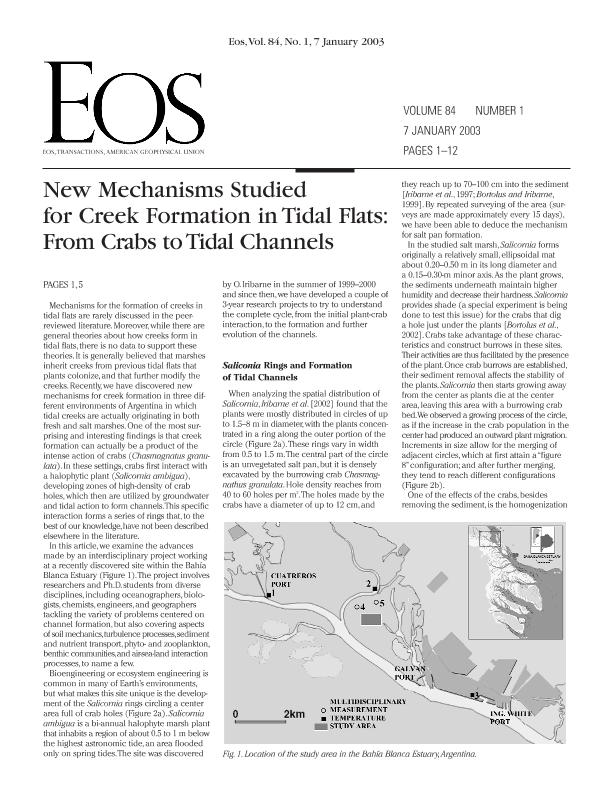Mostrar el registro sencillo del ítem
dc.contributor.author
Perillo, Gerardo Miguel E.

dc.contributor.author
Iribarne, Oscar Osvaldo

dc.date.available
2017-12-12T14:58:09Z
dc.date.issued
2003-06
dc.identifier.citation
Perillo, Gerardo Miguel E.; Iribarne, Oscar Osvaldo; New mechanisms studied for creek formation in tidal flats: From crabs to tidal channels; AGU.Publications; Eos Transactions - American Geophysical Union; 84; 6-2003; 1-5
dc.identifier.issn
0096-3941
dc.identifier.uri
http://hdl.handle.net/11336/30256
dc.description.abstract
Mechanisms for the formation of creeks in tidal flats are rarely discussed in the peer- reviewed literature. Moreover, while there are general theories about how creeks form in tidal flats, there is no data to support these theories. It is generally believed that marshes inherit creeks from previous tidal flats that plants colonize, and that further modify the creeks. Recently, we have discovered new mechanisms for creek formation in three dif- ferent environments of Argentina in which tidal creeks are actually originating in both fresh and salt marshes. One of the most sur- prising and interesting findings is that creek formation can actually be a product of the intense action of crabs ( Chasmagnatus granu- lata ). In these settings, crabs first interact with a halophytic plant ( Salicornia ambigua ), developing zones of high-density of crab holes, which then are utilized by groundwater and tidal action to form channels.This specific interaction forms a series of rings that, to the best of our knowledge, have not been described elsewhere in the literature. In this article, we examine the advances made by an interdisciplinary project working at a recently discovered site within the Bahía Blanca Estuary (Figure 1).The project involves researchers and Ph.D. students from diverse disciplines, including oceanographers, biolo- gists, chemists, engineers, and geographers tackling the variety of problems centered on channel formation, but also covering aspects of soil mechanics, turbulence processes, sediment and nutrient transpor t, phyto- and z ooplankton, benthic communities, and air-sea- land interaction processes, to name a few. Bioengineering or ecosystem engineering is common in many of Earth’s environments, but what makes this site unique is the develop- ment of the Salicornia rings circling a center area full of crab holes (Figure 2a). Salicornia ambigua is a bi-annual halophyte marsh plant that inhabits a region of about 0.5 to 1 m below the highest astronomic tide, an area flooded only on spring tides.The site was discovered by O. Iribarne in the summer of 1999–2000 and since then, we have developed a couple of 3-year research projects to try to understand the complete cycle, from the initial plant-crab interaction, to the formation and further evolution of the channels.
dc.format
application/pdf
dc.language.iso
eng
dc.publisher
AGU.Publications
dc.rights
info:eu-repo/semantics/openAccess
dc.rights.uri
https://creativecommons.org/licenses/by-nc-sa/2.5/ar/
dc.subject
Creek
dc.subject
Tidal Flat
dc.subject
Formation
dc.subject
Crabs
dc.subject.classification
Meteorología y Ciencias Atmosféricas

dc.subject.classification
Ciencias de la Tierra y relacionadas con el Medio Ambiente

dc.subject.classification
CIENCIAS NATURALES Y EXACTAS

dc.title
New mechanisms studied for creek formation in tidal flats: From crabs to tidal channels
dc.type
info:eu-repo/semantics/article
dc.type
info:ar-repo/semantics/artículo
dc.type
info:eu-repo/semantics/publishedVersion
dc.date.updated
2017-12-04T17:30:06Z
dc.journal.volume
84
dc.journal.pagination
1-5
dc.journal.pais
Reino Unido

dc.journal.ciudad
londres
dc.description.fil
Fil: Perillo, Gerardo Miguel E.. Consejo Nacional de Investigaciones Científicas y Técnicas. Centro Científico Tecnológico Conicet - Bahía Blanca. Instituto Argentino de Oceanografía. Universidad Nacional del Sur. Instituto Argentino de Oceanografía; Argentina
dc.description.fil
Fil: Iribarne, Oscar Osvaldo. Consejo Nacional de Investigaciones Científicas y Técnicas. Centro Científico Tecnológico Conicet - Mar del Plata. Instituto de Investigaciones Marinas y Costeras. Universidad Nacional de Mar del Plata. Facultad de Ciencia Exactas y Naturales. Instituto de Investigaciones Marinas y Costeras; Argentina
dc.journal.title
Eos Transactions - American Geophysical Union

dc.relation.alternativeid
info:eu-repo/semantics/altIdentifier/doi/http://dx.doi.org/10.1029/2003EO010001
dc.relation.alternativeid
info:eu-repo/semantics/altIdentifier/url/http://onlinelibrary.wiley.com/doi/10.1029/2003EO010001/epdf
Archivos asociados
